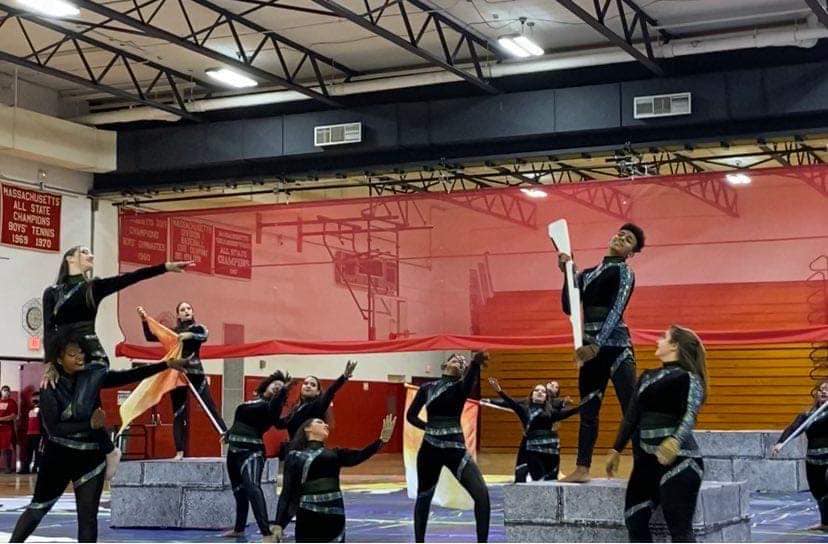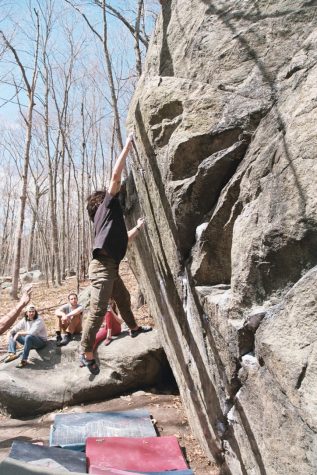DHS Winter Guard and Indoor Winds: Diamonds under Pressure
Within the last week we did a piece on indoor percussion, but we should not discredit the esteemed winter guard and winds ensembles at DHS. The winter guard and winds are the artistic embodiment of diamonds made under pressure. It was an honor to get to interview such passionate artists and learn the mental toughness that comes with producing stunning routines and harmonious musical arrangements.
“It’s a lot of pressure knowing that people are watching me and just hearing that applause boosts your confidence,” said sophomore Jesse Walker, weapon soloist for the DHS Winter Guard.
This point is consistently reported by the following three student interviews.
Sophomore Lola O’Brien and Sophomore Tabitha Cobb, both flag and dance artists in the winter guard, repeat the concept: the pressure can be crushing for those not accustomed to it. Another detail, however, is uniformly repetitive when talking about the pressure of their work: a smile, prideful, yet humble, appears, as in instinct or memory.
The winter guard theme, according to senior Genevieve Chedid, is a story of self-discovery through music from the point of view of singer Alanis Morissette’s music. A stunning parallel to Chedid’s own experience in winter guard.
“I’m not the same person that I was in seventh grade before I started this [winter guard]. I like who I am now; I like where I am.”
As a senior captain of the winter guard, she reveals hopeful news to those for whom pressure is prevalent in winter guard. “I am not as scared. Once you’ve done it for a couple of years, you realize that [competitors] are students too. They go through the same thing I do. Everyone makes mistakes.”
This insightful wisdom, acquired from years of practice, offers the idea that pressure perfects, and becomes inferior to the benefits of family and skill that come with the program.
“I’ve never had an experience like [winter guard] before. It’s made me grow as a person,” said O’Brien as she explains the give and take nature of the pressure in winter guard.
Being in the winter guard, and in a larger context the band itself, is a serious time commitment, and learning curve. Many of us can barely cope with the pressure of presenting to a class of peers. Now imagine performing in front of a larger audience with judges and other artists analyzing you, and your instructors expecting your best.
“You can’t let your mistakes defeat you,” said O’Brien. This embodies that, in winter guard, you may begin young and nervous, but as you push through mistakes, you become conditioned to pressure and professionalism.
“To be the best of the best you have to dedicate your own time,” Walker said, the pride of being a part of the Boston Crusaders Drum and Bugle Corps radiating off him, raising a feeling of pride for him in myself. “It’s very stressful; each year gets a little harder.”
Later, Cathy Banville, Secretary to the Music Director, added to Walker’s point. “They’re getting more and more creative,” she said. “Every year they’re raising the bar a little bit higher.”
This makes it clear that the indoor programs do not settle for best, but instead they take it upon themselves to become leaders in their art, an inspirational initiative all students could benefit from.
This is the first year of the DHS Indoor Winds program, and they are starting at WGI A-Class level with the goal of World Class long term. A-Class is by no means a basic level, however. “A-class is still a top tier in the country,” said Director of Music Ian Flint. A-Class is an achievement in itself, and to get to World Class not only takes skill but years of competition.
The theme for the indoor winds show this year is a creative concept of mechanical and fluid music, six minutes in total. The show begins choppy and mechanical, and as the show progresses, it becomes more harmonious and human, eventually reaching a peak of fluidity then devolving back into a machine. Perhaps a concept inspired by human (r)evolution itself, starting in assembly lines and the factory work of the industrial early 1900s, progressing through the disco-fueled 70s and 80s, and now, when modern technology is fundamental to society.
The practice time that goes into six minutes, however, is an outlandish concept to those who don’t participate. Being in indoor percussion, winds, or winter guard requires three to four practices a week that are typically three hours each.
“In a typical rehearsal, if the show is five minutes, we might only work on a minute of the show in three hours,” Mr. Flint said. At this point, my jaw hit the floor, due to complete and utter astonishment. That meticulous attention to detail of everyone performing at their best demonstrates the standards to which the programs hold themselves, and the work they are willing to put in to achieve greatness.
It should be noted that most of the indoor winds are especially young, most of the ensemble being in eighth and ninth grade. “It’s a lot of learning and a lot of new things; it’s very new,” said sophomore winds musician Shubhan Swamy.
The budding program is hungry for success, and from the amount of work being put into it, I doubt anything will stand in indoor winds’ way. All three groups, indoor percussion, indoor winter guard, and indoor winds, placed first in their respective divisions within the last week with their sights set on future wins.
End Notes
- Does more work in one week than I will by senior year, (Amazing).
- Unbiased to any specific group, (Proud).
- !











